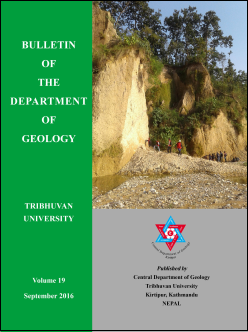Evaluation of aggregates from conglomerate beds of the Upper Siwalik Subgroup, Chure Khola area, Central Nepal Sub-Himalaya
DOI:
https://doi.org/10.3126/bdg.v19i0.19987Keywords:
Texture, Grain interlocking, Micropetrographic index, Index properties, Construction materialAbstract
Durability of infrastructures demands detail study of rocks which helps to give knowledge on physical properties, strength and durability of rocks, and their usefulness as construction materials. A wide belt of conglomerates of the Upper Siwalik Subgroup (Pliocene to Lower Pleistocene) extends in the Chure Hills of Central Nepal. These conglomerates are mostly loosely consolidated, matrix-supported and containing clast of diverse composition. Because of haphazard mining of the riverbeds of the Chure and Dudhaura Kholas, the present study was carried out for evaluation of clasts from the conglomerates distributed at the hillslopes of the Chure Khola, as alternative sources mainly for unbound pavement. Stiffness and durability of clasts from conglomerates was tested for grading, shape indices, Water Absorption Value (WAV), specific gravity, Aggregate Impact Value (AIV), Aggregate Crushing Value (ACV), Los Angles Abrasion Value (LAV), Sodium Sulphate Soundness Value (SSSV) and Slake Durability Index (SDI). The suitability of clast from conglomerates for unbound pavement was finally evaluated for the sample for intended uses following specifications of British standard, ASTM standard and Nepal standard.
The clasts of conglomerate beds are composed of quartzite, sandstone, siltstone, schist, marble, phyllite, granite, limestone and amphibolite. Among all those clasts, quartzite is dominant in all samples. The texture of clast is smooth and rough surface. Flakiness index (FI) and Elongation index (EI) indicate that aggregates possess only some flat and elongate grains and are good in workability. WAV lies below 3% and the dry density (2260kg/m3–2750kg/m3) of aggregates, coincides with the standard average value of ASTM Standard, British Standard and Nepal Standard. The ACV of the sample lies in the range 17% to 26% within the limit of ASTM standard, BS and Nepal Standard. The Los Angles Value of the sample lies in the range 34% to 44.60% and therefore, they can be used for base course and sub base course. SSSV for five cycles was calculated to be less than 10%. SDI after second cycle is very high (94.29%) and samples are durable in nature according to ASTM D4644- 87 Standard. All parameters show that the sample of the clast of conglomerate deposited along the Chure Khola are durable meeting all ASTM, British and Nepal Standard and thus are suitable unbound pavement.
Bulletin of the Department of Geology, vol. 19, 2016, pp. 1–14
Downloads
Downloads
Published
How to Cite
Issue
Section
License
© Central Department of Geology, Tribhuvan University, Nepal

